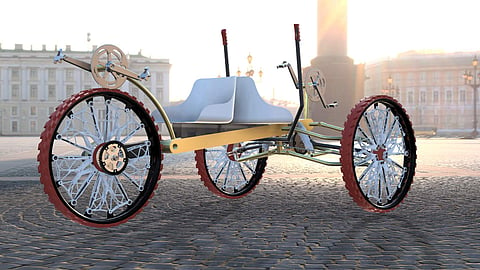

A team of young innovators from Birla Institute of Technology and Science (BITS), Pilani, have been selected by NASA to represent India at the Human Exploration Rover Challenge (HERC) 2022. The finals, which will be held in April at NASA's George C Marshall Space Flight Center at Huntsville, Alabama, will see the participation of 91 teams from around the world, at both the college and high school levels.
The 25-member team called Inspired Karters Gravity lays their claim to glory in the fact that they have met the requirements set by NASA, with two important inventions that drive its rover. The challenge essentially requires participants to design and put together a rover that is entirely controlled by humans and does not employ batteries or electricity to generate power. Additionally, it must be able to manoeuvre across an obstacle course that imitates the terrain of Mars and fulfill 12 challenges and a range of tasks in order to be declared the winner.
The BITS team first worked on reducing the weight of the rover so that the power requirement of the vehicle is discounted. "We substituted steel for aluminum, but ensured that there was no compromise on strength," says team leader Vedant Jasu. "The rover is built to be ridden like a bicycle and its design has taken after the 'Tadpole trike', with belts in place of chains which adds to the intention of making the rover lightweight and improves the efficiency of the vehicle, given the fact that it requires very little maintenance," adds Parth Saboo, the team's Chief Technical Officer. However, one of the in-house innovations that have given this team the edge is are their unique 3D-printed wheels, which are economical and are purported to improve performance on the terrain of Mars. However, what really gives this team the edge is their unique suspension system that promises a seamless drive on bumpy terrain.
What really drives these young engineers on this project is the chance to learn from scientists at NASA first-hand on the rover and get invaluable inputs and feedback from them. And while NASA gets design ideas from these events, what the students get is a sense of pride at having represented their country at an international level and the wealth of experience that comes with the course of this event. "What NASA is looking for is the agility with which the teams work, both in terms of innovation and efficiency. And we have focused a lot on our teamwork," says the vice-captain, Udbhav Tripathi. All three members are third-year students of mechanical engineering.
While the design is done and dusted, the team is looking to build the rover in January after their exams end. They believe they will finish it by February. They had started conceptualising last year, when the team was still in its second year of engineering and have been working on the design remotely, given the pandemic-induced lockdowns. However, they are now back on campus and charged for the next stage of the event.
The team’s sponsorship head, Ekansh Agarwal, is excited about the possibility of a scaled-up model of this handy rover aiding in the possible colonisation of Mars. "If that is the future we are looking at, then a vehicle that depends on the sustainable form of energy is our best bet," he says and adds that building connects with those in the industry and his institution's alumni have helped the team gather the funds required for the project.
The competition stresses on innovation. Both in terms of what the teams do with their own projects (no team is allowed to borrow more than 40% from their previous rover designs), as well as how they incite passion for STEM in the younger communities in their countries. The BITS team has taken on this challenge head-on. We are approaching government schools around campus to conduct online activities such as DIY Science experiments and making complex science concepts easily understandable. We'll be telling them about the current state of STEM, especially space-tech, and we're starting off with things that can be fun and simple such as the aerodynamics of a paper plane. The motivation is to make them aware of these domains as well, and let them pursue careers in these fields," adds Udbhav. He says that the competition has instilled a lot of confidence in the team with regards to their ability to innovate, tinker with, and develop their rover.
